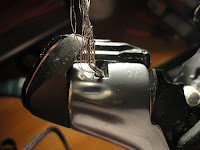 |
| A frayed, partially broken shift cable |
My first road bike (a 1964 Garlatti) had shift levers on the down tubes: you could follow the entire length of the cables running from the levers to front and rear derailleur. Not so my current road bikes (a 1994 Trek 1400 and a 2015 Fuji Altamira): they both have Shimano STI® integrated shifters, with the end of the shift cable concealed inside the shifter beneath the rubber “hood.” Cables, in case you didn't know, aren't solid wires: they’re made of multiple strands of stainless steel braided together, which allows them to be flexible while minimizing stretch.
Each time you shift your bike, that cable bends slightly with the lever's rotation. After hundreds of these tiny movements, even steel strands become fatigued and break (see image): it's the same thing as repeatedly bending a steel paper clip. One or two broken strands will not affect shifting, but as more and more strands break, the cable becomes “stretcher.” A stretchy cable doesn't move the derailleur the expected distance, so your shifting becomes sloppy and the chain flops around on the cluster. No amount of fiddling with limit screws or barrel adjusters (you do know what those are, right?) will correct the problem: you have to replace the cable, preferably before it breaks completely.
Shift Cables
 |
| A deteriorated cable viewed in position in the shifter |
Replacing a Shift Cable
Replacing deteriorated shift cable(s), and housings if necessary, is a task a competent DIY mechanic can perform. You’ll need new cables, of course, and a cable cutter tool, especially if you’re also replacing he housing. Regular wire cutters aren’t sharp enough to cut the cable and will crush the housing, though some say that bolt cutters work for cables. If you do replace housings, the new housing must be the same length as the one it replaces. New ferrules (the “caps” on the end of the housing) are also in order and are typically included with the housing.
Brake Cables
The cables for caliper brakes operate on the same principle as shift cables: there’s a braided stainless steel cable within a plastic housing of a specified length. These cables are heavier than shift cables, and the two are not interchangeable. Replacing them is similar to replacing shift cables.
copyright © 2018-2020 scmrak

No comments:
Post a Comment